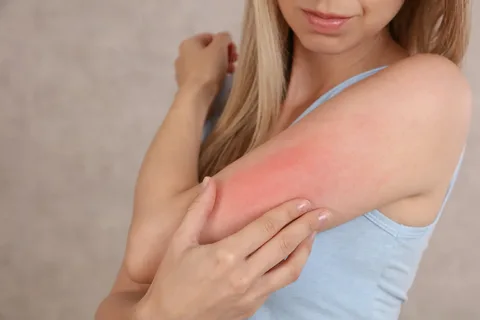When summer arrives with full force, sensitive skin faces extra challenges as allergic reactions. Hot sun, humidity, excessive sweat, airborne allergens, chlorinated pools, and harsh UV rays can all provoke heat rashes, prickly heat, hives, or other allergic skin reactions. For those with delicate or reactive skin, these summer aggressors aren’t just nuisances—they can be painful, distressing, and persistent.
At First Point MD, we aim to offer you a comprehensive, practical, and medically grounded guide to protecting and soothing sensitive skin during the hottest months. In this article, we explore the scientific basis of summer skin reactions, distinguish between heat rash and allergic responses, and present actionable prevention and treatment strategies to keep your skin calm, healthy, and comfortable.
Why Sensitive Skin Suffers More in Summer
Sensitive skin—characterized by a lower threshold for irritation, weak barrier function, and a propensity to react to environmental triggers—becomes especially vulnerable in summer. Some of the key contributing factors:
-
Increased sweating & humidity: Excess moisture can clog pores and sweat ducts, triggering heat rash (miliaria or prickly heat).
-
UV exposure and photodermatitis: Sunlight can instigate allergic reactions (sun allergy, polymorphous light eruption) in predisposed individuals.
-
Allergens and irritants: Pollen, mold spores, dust, and airborne chemicals rise in summer. For those with atopic dermatitis or a history of urticaria, these triggers can inflame the skin.
-
Increased contact with plants and insects: Summer means more exposure to poison ivy/oak, insect bites, and skin contact with grasses or shrubs—each of which can provoke allergic dermatitis. Pool chemicals, chlorine, salt water: Chlorine or salt residuals can strip lipids, weaken the barrier, and provoke stinging or dryness in reactive skin.
-
Heat stress on the skin barrier: Elevated heat can deplete skin’s natural defenses (lipids, ceramides), making it more permeable to irritants.
Given these forces, a robust and targeted strategy is essential to minimize flare-ups, calm symptoms, and prevent recurrence.
Heat Rash vs Allergic Skin Reactions: Key Differences
Before choosing a treatment path, you must distinguish whether you’re dealing with heat rash (miliaria/prickly heat) or an allergic/immune-mediated rash (hives, contact dermatitis, sun allergy).
| Feature | Heat Rash (Miliaria / Prickly Heat) | Allergic / Immune Skin Reaction |
|---|---|---|
| Cause | Blocked sweat ducts, causing sweat to be trapped beneath skin | Immune system response to allergen (contactant, UV, food, substance) |
| Onset | Gradual in hot, humid conditions, worsens with sweating | May appear suddenly after exposure (e.g. sunscreen, plant, insect bite) |
| Appearance | Tiny pinhead bumps or clear fluid-filled vesicles; red, itchy or prickly feeling. | Raised wheals (hives / urticaria), eczema-like patches, redness in reaction pattern |
| Distribution | Typically in skin folds, under clothing, where there is occlusion | Localized to contact area or widespread (if systemic allergen) |
| Symptoms | Prickling or stinging, rarely intense pain or bleeding | Itching can be intense; may blister, ooze, or become chronic |
| Course | Usually self-limited with cooling and drying | May persist until allergen removed; may respond to anti-histamines or steroids |
In practice: if your rash worsens with heat and sweat, and improves in cooler settings, heat rash is likely. If it flares after contact with certain products or plants, or appears suddenly and spreads, suspect an allergic reaction.
Preventing Summer Skin Issues for Sensitive Skin
Prevention is always better than cure—especially when your skin is delicate. Here’s our evidence-based, dermatologist-aligned roadmap for avoiding heat rashes and allergic reactions:
Choose Breathable, Loose Clothing
-
Wear lightweight, natural fabrics (cotton, linen, bamboo blends) that wick moisture and allow air circulation. Synthetic fabrics may trap heat and sweat.
-
Avoid tight, restrictive garments, especially in hotspots like underarms, waist, or behind knees.
-
Change sweat-soaked clothes promptly to reduce skin irritation.
Stay Cool & Control Indoor Climate
-
Use air conditioning, ceiling fans, or portable fans to maintain lower indoor humidity.
-
Shade your home with curtains or blinds to reduce heat gain.
-
Exercise outdoors early in the morning or late evening when heat is lower.
Minimize Sweat Buildup
-
Keep highly active periods brief; take frequent breaks in shade.
-
Use cool showers or baths to rinse away salt, sweat, and pollutants.
-
Gently pat skin dry—avoid rubbing or toweling vigorously, which can aggravate irritation.
Use Gentle, Minimalist Skincare
-
Opt for fragrance-free, non-comedogenic, and hypoallergenic cleansers and moisturizers.
-
Avoid thickeners, heavy oils, or occlusives that might clog pores in skin already stressed by heat.
-
Use a light moisturizer (gel or lotion) post-cleansing to maintain the barrier without suffocating skin.
Sun Protection—Smart & Sensitive
-
Use broad-spectrum, mineral-based (zinc oxide / titanium dioxide) sunscreen with SPF 30 or higher designed for sensitive skin.
-
Apply generously and reapply every two hours—or more after sweating or swimming.
-
Consider sun-protective clothing, wide-brimmed hats, sunglasses, and shade-seeking behavior.
-
Test new sunblock on a small patch first, as sunscreens themselves may trigger contact reactions in sensitive individuals.
Avoid Known Irritants / Allergens
-
Patch-test new skincare or laundry products.
-
Avoid strong fragrances, essential oils, or dyes, especially in the summer when the skin barrier is more vulnerable.
-
Be cautious with topical insect repellents, chlorinated pools, or salt water—rinse thoroughly after exposure.
Calm Triggers from Nature
-
Be aware of contact allergens such as poison ivy/oak, which are more present in summer. Wash exposed skin and clothing immediately.
-
Use insect repellent judiciously and promptly treat stings or bites to prevent overreaction.
Hydration and Nutrition
-
Drink adequate water to support skin hydration from within.
-
Eat antioxidant-rich foods (berries, leafy greens) to bolster skin resilience.
-
Avoid excess caffeine or alcohol, which may dehydrate skin.
Safe & Effective Treatments When a Rash Appears
Even with the best prevention, rashes may still occur—especially in sensitive individuals. Here’s how to treat them effectively and safely:
For Heat Rash (Miliaria / Prickly Heat)
-
Cool & dry the area
-
Relocate to a cooler environment.
-
Use cold compresses or damp towels.
-
Avoid additional heat or friction.
-
-
Gentle cleansing
-
Use lukewarm water and mild cleansers.
-
Avoid harsh scrubs or exfoliants.
-
-
Avoid pore-blocking substances
-
Skip heavy creams, oils, or thick ointments while rash is active.
-
Light lotions or calamine may help soothe irritation.
-
-
Topical soothing agents
-
Over-the-counter options like 1% hydrocortisone cream (short-term) may be used if itching is bothersome.
-
Colloidal oatmeal baths, aloe vera gel (pure, no additives), or cooling sprays can reduce irritation.
-
Avoid strong antihistamine creams unless prescribed.
-
-
Do not scratch or pick
-
Scratching can lead to skin breakage, secondary infection, or scarring.
-
-
Monitor & escalate care if needed
-
If rash persists beyond a few days, worsens, becomes painful, or shows signs of infection (pus, fever, swelling), consult a dermatologist.
-
For Allergic / Contact Skin Reactions (Hives, Eczema, Contact Dermatitis)
-
Identify and remove the trigger
-
Discontinue suspected new skincare, detergent, or exposure to plants.
-
Wash affected area gently to remove residues.
-
-
Cold compresses
-
Apply cool, damp cloths to reduce inflammation and soothe itching.
-
-
Topical treatments
-
Low-potency corticosteroid creams (e.g. 0.5–1% hydrocortisone) can reduce inflammation.
-
Calamine lotion or colloidal oatmeal may relieve mild itching.
-
Barrier repair creams (ceramide-based, fragrance-free) help support the skin’s integrity.
-
-
Oral antihistamines
-
Non-sedating antihistamines (cetirizine, loratadine) help relieve hives or itching when rash is more widespread.
-
-
Avoid hot water & friction
-
Use tepid water for showers, pat dry gently, and wear soft cotton clothes.
-
-
When to see a specialist
-
For large areas, severe swelling, blistering, or widespread rash not responding to basic care, seek professional care.
-
Patch testing may help identify allergens in persistent or recurrent reactions.
-
Special Considerations & Tips for Vulnerable Populations
-
Children: Their sweat glands are immature, making heat rashes more common. Use superfine breathable cotton, avoid over-bundling, and use gentle baby-safe products.
-
Eczema-prone skin: Heat and sweat often worsen atopic dermatitis. Maintain regular moisturization, use gentle cleansing, and have a flare plan (topical steroids, non-steroid anti-inflammatories).
-
Pigmented skin: After inflammation, postinflammatory hyperpigmentation (dark spots) or hypopigmentation (lighter spots) can linger—gentle care is essential.
-
People with sun allergies or photosensitivity: Strict sun protection, avoidance of triggering medications, and prompt dermatologic care for eruptions are crucial.
Putting It All Together: Daily Sensitive Skin Summer Routine
-
Morning Routine
-
Cleanse with gentle, fragrance-free cleanser (lukewarm).
-
Apply a lightweight, non-comedogenic moisturizer.
-
Apply a mineral-based broad-spectrum sunscreen (SPF 30+).
-
Dress in breathable, natural fabrics.
-
-
Throughout the Day
-
Stay in shade or air-conditioned areas when possible.
-
Pat away sweat with a soft cloth—don’t rub.
-
Reapply sunscreen after perspiration or swimming.
-
Keep hydrated.
-
-
After Outdoor / Pool Exposure
-
Rinse chlorine or salt water promptly with fresh water.
-
Gently cleanse; avoid harsh scrubbing.
-
Apply a soothing, lightweight moisturizer.
-
-
Evening & Night
-
Take a cool shower or bath to remove sweat, dirt, and debris.
-
Use a repair moisturizer or barrier cream (without heavy occlusives).
-
Wear loose, breathable pajamas.
-
-
At First Sign of Irritation
-
Apply a cool compress, mild calming gel, or calamine lotion.
-
Minimize heat, friction, and further stress on the skin.
-
Use low-dose hydrocortisone cream if needed and short-term.
-
Monitor and escalate to dermatology if symptoms worsen or persist.
-
When to Seek Professional Help
Contact a dermatologist (or your healthcare provider) if:
-
Rashes are painful, spreading, blistering, or oozing
-
You have fever, chills, or systemic symptoms
-
There is persistent or recurrent rash despite care
-
You suspect infection (warmth, swelling, pus)
-
Reactions appear after using a new product or medication
-
You need help identifying triggers or managing chronic skin conditions
Conclusion: Protecting Sensitive Skin in Summer
Summer can be a season of stress for sensitive skin—but it doesn’t have to be a season of suffering. A thoughtful combination of prevention, gentle daily care, trigger-awareness, and targeted treatments empowers you to enjoy warm weather without compromising your skin’s health.
At First Point MD, we encourage you to listen to your skin, adopt smart strategies early, and act gently but proactively. With the right approach, even the hottest, most humid days can pass without leaving your skin in distress.


